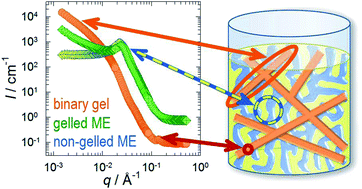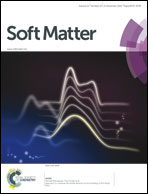Studying orthogonal self-assembled systems: microstructure of gelled bicontinuous microemulsions†
Abstract
An orthogonal self-assembled system consists of different structures which coexist independently. Furthermore, the characteristic properties of the respective “base systems”, i.e. of the systems which contain only one of the structures, are retained in the orthogonal self-assembled system. We have identified gelled bicontinuous microemulsions as orthogonal self-assembled systems and reported in a preceding paper (Soft Matter, 2013, 9, 3661) that their phase behaviour and rheological properties are in perfect agreement with those of the two base systems, namely a non-gelled bicontinuous microemulsion and a binary gel. In the paper at hand we present the results of structural investigations. With FT-PGSE 1H-NMR measurements we verified the bicontinuity of our gelled model system H2O–n-decane/12-hydroxyoctadecanoic acid (12-HOA)–tetraethylene glycol monodecyl ether (C10E4) at appropriate temperatures. Apart from that, we proved the coexistence of the bicontinuous microemulsion domains with the gelator network in a small angle neutron scattering (SANS) study. A qualitative comparison between the SANS data of the gelled bicontinuous microemulsion and those of its base systems reveals that the characteristic scattering features of both base systems are present. Moreover, we were able to quantitatively describe and interpret the SANS data, yielding at the same time the structural parameters of the bicontinuous microemulsion and the gelator network.


 Please wait while we load your content...
Please wait while we load your content...